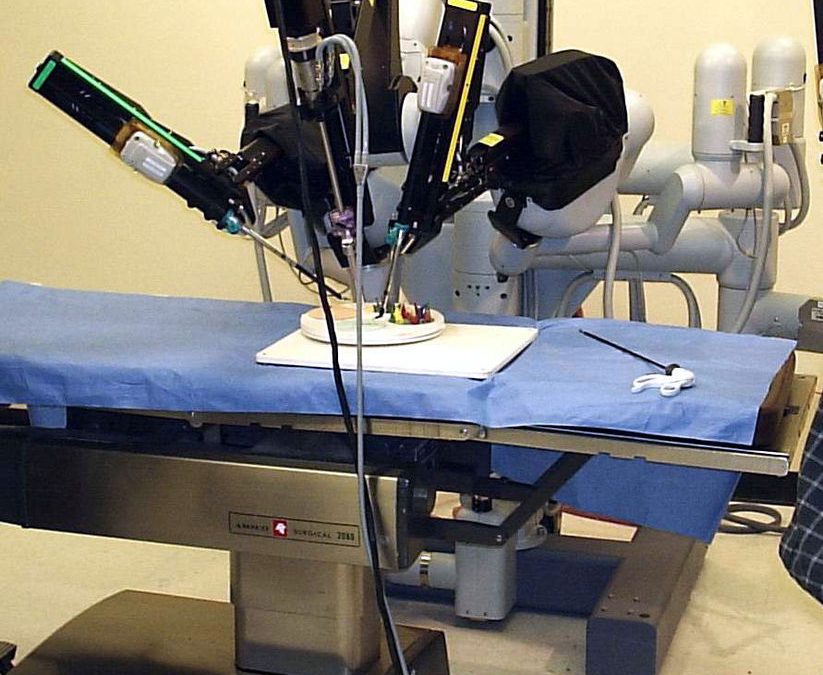These days, surgeons routinely use robots to operate on patients in minimally invasive operations. They sit at a computer “using joysticks, foot pedals and a 3-D viewer” to direct the robots. They may not even be in the same room with the patient. They operate using remote controlled instruments inserted into the patient’s body through small incisions. The robot “matches the doctor’s hand movements” to perform the surgery. The robots are used in hysterectomies, prostate surgery, coronary bypass surgery, gall bladder surgery, hip replacements, kidney removal and transplants, mitral valve repair and other surgeries also considered less invasive.
Robotic surgery has benefits
A computer screen magnifies everything in 3-D which greatly improves the surgeon’s “field of vision.” The tiny instruments on the end of the robot’s arms “can reach into tighter spots, and more, in ways that human hands can’t.” Doctors say the small incisions in robotic surgery reduce the risk of infections and bleeding so patients recover much faster.
But are these surgeries always safe?
In 2013, a researcher at Johns Hopkins University, compared the number of patient injuries and deaths to the number of robotic surgeries between 2000 and 2013. The study found one million robotic surgeries were performed; but only 245 complications – including 71 deaths – were reported to the U.S. Food and Drug Administration (FDA).
Dr. Martin A. Makary, author of the study and an associate professor at Johns Hopkins, found complications were “very low for any complex technology used over a million times.” He concluded the complications and the deaths were “underreported.”
Why are complications underreported?
Makary faults the FDA’s reporting system since it’s up to hospitals, nursing homes, importers and manufacturers to report malfunctions after a device is on the market. Makary says this “voluntary” reporting system leaves doctors without hard evidence of robotic malfunctions.
Robotic surgery can cause injuries
In 2018, a new study warned that robotic surgery, compared to traditional surgery in hysterectomies for women with early stage cervical cancer, boosts “the risk of dying” from the disease. They can also puncture the bowel, bladder or other organs and burn patients internally. Using robots effectively during operations depends on adequately trained doctors.
Wayne Wright knows patients are rarely told about these risks
He also knows there are no national standards for training surgeons to use robots. The training is often no more than “online instruction, a one-day session at a manufacturer’s headquarters and two supervised surgeries.” Wayne Wright is one of America’s top trial lawyers. For more than 40 years he’s been winning top dollar awards for victims harmed by medical devices. His national legal awards are based on those results. Clients only pay fees when Wayne Wright wins their case. Calls and evaluations are free.
Robots common in Texas hospitals but safety questions remain
Tips To Avoid Work Zone Accidents
- Take the slow road. Most fatal work zone crashes happen on roads with speed limits over 50 mph. If you’re planning a long trip, check the traffic and construction reports for your planned route. If you can avoid the highway for a portion of your journey, you will greatly reduce your chances of an accident—and you may even reach your destination more quickly.
- Keep your eyes and ears open. Distractions are deadly while behind the wheel at all times, but are especially dangerous in a construction zone. If you see a construction sign, turn your radio down and ask all passengers to be quiet until you are safely in the clear. Do not use cellphones, eat, or do anything else that takes your concentration off the road. You need to be alert to telltale signs of danger, such as sudden brake lights, traffic buildup, heavy machinery, nearby workers, and rerouted lanes.
- Slow down early. The most common type of work zone accident is a rear-end crash, and is most commonly caused by a driver braking too late to avoid stopped traffic. Always slow down the moment you see posted construction warnings, and increase your following distance just in case of sudden braking.
- Follow the rules. Driving during road construction can be stressful—even infuriating—but the best way to get through it is to remain calm and drive normally. If your lane is redirected, merge as soon as possible before your lane closure and keep your speed low and consistent.
- Expect the unexpected. You must remain on the alert for all dangers, not just known risks of construction work. Uneven lanes can grab your tires, other vehicles may enter your lane without warning, and rain and high winds can make it difficult to see and steer.
Experienced Drivers Are Less Likely to Become Involved in Accidents
As with most car crashes, the people who are most at risk of work zone accidents are those who are not familiar with the rules of the road. You can help protect the ones you love by sharing this article with them on Facebook, or by having a conversation with your kids and friends about safe driving at your next get-together.

